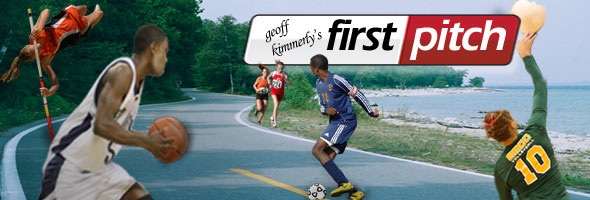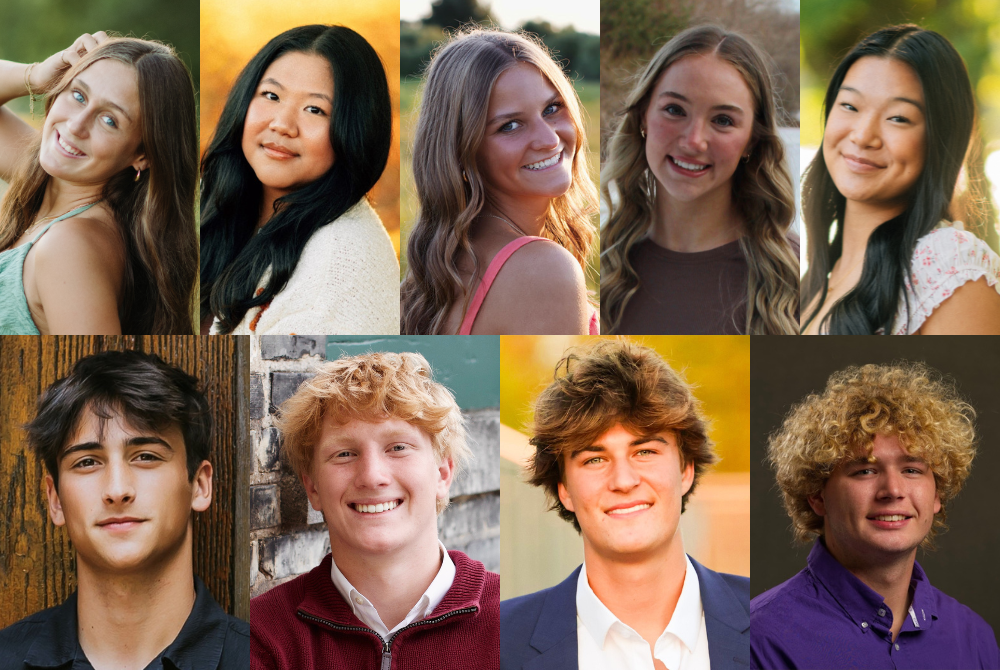
Things change; lessons are the same
February 29, 2012
Let's start with the obvious: High school sports have evolved a bit since 1927.
But the MHSAA Bulletin from March of that year -- dug up by one of our directors on another research pursuit -- reminds us how some of our challenges remain the same.
Below are a few excerpts from the section titled "Baseball and Sportsmanship." Keep in mind, baseball was the football and basketball of the first half of the 1900s. The 1927 New York Yankees arguably were the greatest baseball team of all-time, finishing 110-44 thanks to Babe Ruth, Lou Gehrig and others.
Those names alone make us think in a historical context -- which makes the parallel between today and the following that much more intriguing:
Baseball games furnish a difficult problem to schools in the matter of sportsmanship, spectator control and their education.
Many more people are familiar with the game of baseball and its rules than is true of either football or basketball. Consequently, they feel even more qualified to criticize.
In many places, absence of seating facilities bring the spectators into close proximity to players with the result that criticism of players and of the official and sometimes abusive remarks to the visiting team can occur. No school can hope to improve this situation by ignoring it.
The MHSAA Bulletin went on to cite suggestions for improvement that had been published by the Delaware association. Again, a sampling:
Treat the visiting team as guests, not as deadly enemies. Small youngsters often offend through ignorance. Educate them along this line.
Fair and impartial applause of good plays by either side should be encouraged in the student body, and the outside fans will soon fall in line.
"Razzing" or "riding" visiting players is poor sportsmanship.
Caution your boys to pay no attention to the "grandstand experts" who feel it their duty to offer suggestions as to the work of the team. They can sometimes do more harm in an hour than can be overcome in days of practice.
And a final note from the 1927 MHSAA on the subject:
An athletic contest properly staged and handled creates a favorable impression on the part of visitors toward your school and community. A game that deteriorates into a backyard squabble hurts not only the school and its executives, but the town as well.

2025 Scholar-Athlete Award Recipients Announced in Class B
By
Geoff Kimmerly
MHSAA.com senior editor
February 11, 2025
The Michigan High School Athletic Association has selected nine student-athletes from Class B member schools to receive scholarships through the MHSAA/Farm Bureau Insurance Scholar-Athlete Award program.
 Farm Bureau Insurance, in its 36th year of sponsoring the award, will give $2,000 college scholarships to 32 individuals who represent their member schools in at least one sport in which the Association sponsors a postseason tournament. The first 30 scholarships are awarded proportionately by school classification and the number of student-athletes involved in those classes; also, there are two at-large honorees who can come from any classification.
Farm Bureau Insurance, in its 36th year of sponsoring the award, will give $2,000 college scholarships to 32 individuals who represent their member schools in at least one sport in which the Association sponsors a postseason tournament. The first 30 scholarships are awarded proportionately by school classification and the number of student-athletes involved in those classes; also, there are two at-large honorees who can come from any classification.
Students applying for the Scholar-Athlete Award must be carrying at least a 3.5 (on a 4.0 scale) grade-point average and have previously won a letter in a varsity sport in which the Michigan High School Athletic Association sponsors a postseason tournament. Other requirements for the applicants were to show active participation in other school and community activities and produce an essay on the importance of sportsmanship in educational athletics.
The 32 scholarship recipients will be recognized March 15 during the MHSAA Boys Basketball Finals at the Breslin Student Events Center in East Lansing.
The Class B Scholar-Athlete Award honorees are Madelynn Kreider, Kingsford; Hannah Lee, Ann Arbor Greenhills; Grace McDowell, Whitehall; Addison Seemann, Freeland; Eleana Zhuang, Ann Arbor Greenhills; Oliver Costello, Haslett; Ryan Goodrich, Whitehall; Brayden Bryan Lape, Grass Lake; and Alan Mrva, Corunna.
Overviews of the scholarship recipients of the Class B Scholar-Athlete Award follow. A quote from each recipient's essay also is included:
 Madelynn Kreider, Kingsford
Madelynn Kreider, Kingsford
Played four years of varsity volleyball and will compete in her third of track & field this spring; also played varsity basketball and softball as a freshman. Earned all-state honors her final two seasons of volleyball including making the Division 2 first team this past fall, and served as team captain her final two years. Ran on two Finals-placing track relays and also served as captain for that team. Ranked first in her graduating class academically and participating in second year of National Honor Society. Serving fourth year on student council and as vice president. Also participating in second years of Key Club and as student ambassador for her school, and serving as the social media coordinator in her fourth year with Fellowship for Christian Athletes. Will attend Michigan Technological University and study kinesiology and exercise science.
Essay Quote: “(Sportsmanship) challenges us to choose integrity, even when the stakes are high, and to see every opportunity as a gift from God. Volleyball may have taught me how to hit and set, but sportsmanship taught me how to handle life’s victories and defeats with love and grace. That, above all, is what I will carry with me forever.”
 Hannah Lee, Ann Arbor Greenhills
Hannah Lee, Ann Arbor Greenhills
Played four seasons of varsity golf, helping team to MHSAA Finals all four years and posting top-13 individual finishes at last two championship tournaments. Earned all-state and academic all-state recognition. Participating in fourth year of forensics and also fourth year coaching middle school team; reached state finals as competitor in multiple events. Participating in third year as part of University of Michigan Youth Chamber Singers and also played two years as part of Detroit Symphony Orchestra’s Civic Youth Ensembles. Participating in fourth year of Greenhills Gryphon Sports Live broadcasting club and as president, and participating in fourth year of United Congressional Award Club and as board member. Earned school’s notable research award for work with University of Michigan’s Obstetrics & Gynecology department. Is undecided where she will attend college but intends to study biology and psychology with potentially a minor in business.
Essay Quote: “Sportsmanship in golf is about more than making the right call or showing respect in the moment; it’s about creating a lasting impact on the game, players, and community. It fosters an environment of mutual respect, where competitors aim to elevate each other rather than just defeat one another. Golf teaches that sportsmanship is a mindset, lasting far beyond the final putt.”
 Grace McDowell, Whitehall
Grace McDowell, Whitehall
Played four seasons of varsity golf, is playing her second of varsity basketball and will play her fourth of varsity tennis this spring. Reached MHSAA Finals all four seasons in golf and as a freshman in tennis, and served as captain of both teams. Earned all-state recognition in golf, all-league in that sport and tennis and also all-state academic in tennis. Serving fourth year as student council class president and participating for second year on Michigan Department of Education Student Advisory Council. Participating in second year of National Honor Society and third as part of West Michigan OsteoScholars. Contributing to youth sports as part of No More Sidelines and First Tee programs and as a youth basketball referee. Is undecided where she will attend college but intends to major in pre-medical studies.
Essay Quote: My love for the game and internal drive have enabled me to embrace my competitive spirit. This spirit is paramount to educational athletics; the desire to win can overshadow sportsmanship. Real victories come not from the score but from the character we build as we compete. Being a good sport is showing respect, maintaining humility in victory, and offering support in defeat.”
 Addison Seemann, Freeland
Addison Seemann, Freeland
Played four seasons of varsity volleyball, is playing her fourth of varsity basketball, and also has competed in track & field throughout high school. Earned all-region honors in volleyball and basketball and also all-state recognition in the latter, and earned all-state as part of two track relays. Served as captain of volleyball and basketball teams, and earned academic all-state in basketball as well. Served three years as student council class president and this year as executive president. Participating in second year of National Honor Society and fourth on executive council of Be The Change group. Participated in Great Lakes Bay Regional Youth Leadership Institute as a junior and was a three-time attendee of Midland Area Youth Impact Partnership. Serving fourth year as youth basketball referee. Is undecided where she will attend college but intends to study civil engineering.
Essay Quote: “From a young age, if players feel supported while making mistakes and taking risks, they grow not only as athletes, but as people too. By instilling values of teamwork, compassion, and respect at young ages, these traits are carried on with athletes throughout their lives. A positive environment in sports contributes to a lifelong love for personal development and healthy competition.”
 Eleana Zhuang, Ann Arbor Greenhills
Eleana Zhuang, Ann Arbor Greenhills
Played two years of varsity volleyball, playing second of varsity basketball and will compete in third of varsity track & field this spring. Qualified for MHSAA Finals as part of track relay as a junior and helped that team to multiple league championships. Served as basketball captain and will serve as track captain this upcoming season. Earned all-academic in volleyball. Named AP Scholar with Honor. Serving as senior class secretary and treasurer and East Asian Pacific American Community leader. Participating in third year with Student Service Leaders group and earned National Community Service Ambassador Awards the last two years. Serving second year on Canton Public Library’s Teen Leadership Council. Earned multiple art awards including silver key in Southeast Michigan & Thumb Scholastic Art Awards competition. Will attend University of Michigan and study movement science in school of kinesiology.
Essay Quote: “Our passion for sports drives us, but our compassion for each other makes educational athletics an unforgettable environment where everyone feels respected, valued, and supported. … As athletes, we’re constantly faced with the choice between passion and compassion. In terms of sportsmanship, compassion always comes first. When we lead with compassion, we grow into individuals who uplift those around us, a lesson essential beyond sports. That’s what makes athletics unforgettable.”
 Oliver Costello, Haslett
Oliver Costello, Haslett
Played four seasons of varsity tennis, is competing in fourth on swimming & diving team and intends to play varsity lacrosse this spring; also played junior varsity baseball as a freshman. Earned all-conference and all-area recognition in swimming and earned all-conference recognition in tennis in helping that team reach MHSAA Finals all four seasons and win Regional title as a junior. Earned all-academic honors in both sports and served as team captain of both teams. Participating in second year of National Honor Society and has served as chapter president. Participated in marching band and drumline, and choir, throughout high school, earning Division 1 state ratings in both. Founded and served as president of Intro to Business and Engineering Sciences clubs. Served as youth swim and tennis coach. Will attend University of Michigan and study chemical engineering.
Essay Quote: “I realize there will always be others ahead of me to chase. When we both reach the wall, I can take pride in showing the sportsmanship I’ve developed and in being an example for another young swimmer. No matter how close the race, outside of the pool, we all share the same goal: improvement.”
 Ryan Goodrich, Whitehall
Ryan Goodrich, Whitehall
Played four years of varsity football and competed in varsity wrestling and baseball throughout his first three years of high school, but has been unable to wrestle this winter because of an injury and is not expecting to be able to play this spring. Reached MHSAA Finals twice in wrestling and placed once, and earned all-conference and academic all-conference in all three sports. Also earned academic all-state in wrestling and baseball. Served as football and wrestling team captain. Participating in second year of National Honor Society and has served as chapter president, and participating in third year of Business Professionals of America and as president. Made BPA state and national finals. Serving second year as Link Crew leader and participating in third year with school’s Hope Squad chapter and first as part of student board for First Priority group. Will attend University of Pennsylvania to study philosophy, politics and economics.
Essay Quote: “Fixating on wins can make the fall from the top unbearable, and being consumed by the losses turns small victories into meaningless moments. That’s where sportsmanship comes in. While at face value it can be respecting the referee or playing fair, sportsmanship is truly reflected in how we handle both triumph and failure. That, I believe, is the greatest lesson from sports.”
 Brayden Bryan Lape, Grass Lake
Brayden Bryan Lape, Grass Lake
Played four seasons of varsity football, is playing his fourth of varsity basketball and will play his fourth of varsity baseball this spring. Earned all-state honors in basketball and football and academic all-state honors in all three sports. Also earned all-conference in all three sports and set several school football records. Served as four-year team captain in all three sports. Participated all four years in National Honor Society and served all four years on student council – and fulfilled these duties while earning national acclaim as a vocalist, recording original music and finishing fifth on NBC’s “The Voice” Season 22. Will attend Northwood University and study accounting.
Essay Quote: “It was during this time (while injured and unable to play) that I truly was able to understand the power of sportsmanship. It is more than just shaking hands after a game or congratulating an opponent. Those are important and necessary gestures, but true sportsmanship involves respecting the game, respecting the people involved, and respecting yourself. Realizing this helped me become a better version of myself. I realized it’s about embracing triumph and defeat with grace and humility.”
 Alan Mrva, Corunna
Alan Mrva, Corunna
Played four seasons of varsity football and will compete in fourth of track & field this spring. Earned all-state honors in football and qualified for MHSAA Finals in track & field. Served as team captain multiple seasons for both. Participating in second years of National Honor Society and as part of Corunna Cavalier Ambassadors. Participated in Future Farmers of America throughout high school serving in various leadership roles at the chapter, regional and state levels. Qualified for FFA state competition and was two-time gold-level recipient for skills contest. Serving third year as junior advisor on Shiawassee County Fair Board. Participated in Shiawassee Scholars program throughout high school. Will attend either Michigan State University or Purdue University and study agricultural engineering.
Essay Quote: “Just as in the classroom, sports help us learn through experience. … (That) I learned to take ownership of my actions and respect those around me even when I am at my lowest goes beyond sports. I have used my stance and realized that every interaction I have with another person leaves an impact on their lives. I hope I can build a legacy that future generations of Corunna Cavaliers are inspired by so that one day they use what I have done and become better versions of themselves.”
Other Class B girls finalists for the Scholar-Athlete Award were Madison Cole, Battle Creek Pennfield; Lauren Sundquist, Gladstone; Sierra Grooters, Hudsonville Unity Christian; Nadia Grierson, Ludington; Anna Catherine Boggs, Monroe Jefferson; Marlee Plaxco, Negaunee; Hailey Dodd, Parma Western; Alaina Hanson, Reed City; Alexandrea Komarowski, St Clair; Scarlet Maison, Standish-Sterling; and Cami Kraai, Whitehall .
Other Class B boys finalists for the Scholar-Athlete Award were Maxwell Volk, Chesaning; Isaak Rubley, Dundee; Brayden Joslin, Durand; Corbin Allen, Grayling; Jayse Peterson, Hastings; Caden VanHuis, Holland Christian; Gavin J. Trevillian, Kingsford; Nicholas Caldwell, North Branch; Benjamin Kelenske, Olivet; Blair Scott, Olivet; Owen Feldpausch, Owosso; and Brady Tate, Whitehall.
The Class C and D scholarship award recipients were announced Feb. 4, and the Class A honorees will be announced Feb. 18.
Farm Bureau Insurance of Michigan was founded in 1949 by Michigan farmers who wanted an insurance company that worked as hard as they did. Those values still guide the company today and are a big reason why it is known as Michigan’s Insurance Company, dedicated to protecting the farms, families, and businesses of this great state. Farm Bureau Insurance agents across Michigan provide a full range of insurance services – life, home, auto, farm, business, retirement, Lake Estate®, and more – protecting nearly 500,000 Michigan policyholders.
The MHSAA is a private, not-for-profit corporation of voluntary membership by more than 1,500 public and private senior high schools and junior high/middle schools which exists to develop common rules for athletic eligibility and competition. No government funds or tax dollars support the MHSAA, which was the first such association nationally to not accept membership dues or tournament entry fees from schools. Member schools which enforce these rules are permitted to participate in MHSAA tournaments, which attract more than 1.4 million spectators each year.

